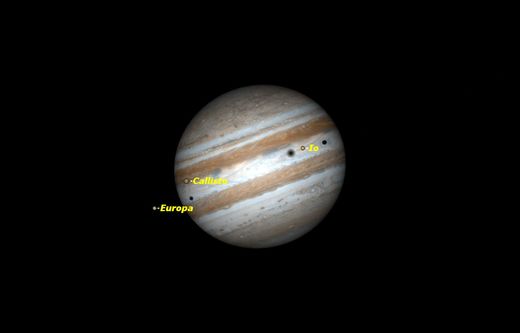
How rare are these Jupiter triple transits? I have seen two in the last 15 years personally, but the next one will not occur until 2032.
As Galileo found early in the 17th century, Jupiter has four large, bright moons that are usually seen as points of light on one side of the planet or the other. These satellites - Io, Europa, Ganymede and Callisto - are known as the Galilean moons, after their discoverer. Jupiter has at least 63 smaller moons, most of which are too small to be seen with amateur telescopes.
As the Galilean moons revolve around the giant planet, they sometimes pass in front of it and sometimes are lost in its shadow or behind the planet itself. In addition, all four moons cast their own shadows on Jupiter's cloud tops.
Because of the complex gravitational interaction between Jupiter and its moons, their motions are not independent, but are locked in specific patterns. The orbital periods of the three inner moons are as follows: Io, 1.769 days; Europa, 3.551 days; Ganymede, 7.155 days.
If you divide these periods by Io's period, you find that they are almost perfectly in the ratio of 1:2:4, a classic example of orbital resonance. Only Callisto doesn't fit the pattern, with an orbital period of 16.689 days.
Because of this resonance, Io and Europa frequently cross the face of Jupiter at the same time, but Ganymede is always far away when this happens.
The inky black shadows of the moons can be seen, under steady seeing conditions, with a 90mm aperture telescope. The shadows are very small, but very high-contrast. The moons themselves are more challenging. I have seen Ganymede and Callisto with a 127mm aperture, but Io and Europa are hard to see with my 280mm aperture, except just as they enter or leave Jupiter's disk. Io and Europa simply blend in with the cloudy surface of the planet.
Here is a rundown of the events Friday night and Saturday morning (Jan. 24), given in EST. If you live in western parts of North America, subtract 1 hour for CST, 2 hours for MST, or 3 hours for PST.
10:11 p.m.Callisto's shadow enters disk
11:35 p.m. Io's shadow enters disk
11:55 p.m. Io enters disk
1:19 a.m. Callisto enters disk
1:28 a.m. Europa's shadow enters disk, triple shadow transit begins
1:52 a.m. Io's shadow leaves disk, triple shadow transit ends
2:08 a.m. Europa enters disk, triple satellite transit begins
2:12 a.m. Io leaves disk, triple satellite transit ends
3:00 a.m. Callisto's shadow leaves disk
4:22 a.m. Europa's shadow leaves disk
5:02 a.m. Europa leaves disk
6:02 a.m. Callisto leaves disk
Notice that the different moons are in front of Jupiter for different periods because of the differences in their orbital speeds. The shadows are at different distances from the moons themselves because of their different distances from the planet. As a result, the triple shadow transit lasts 24 minutes, from 1:28 to 1:52 a.m. EST, but the triple satellite transit lasts only 4 minutes, from 2:08 to 2:12 a.m. EST.
Editor's Note: If you have an amazing photo of Jupiter or any other celestial object that you'd like to sharefor a possible story or image gallery, please contact managing editor Tariq Malik at spacephotos@space.com.



Reader Comments
to our Newsletter